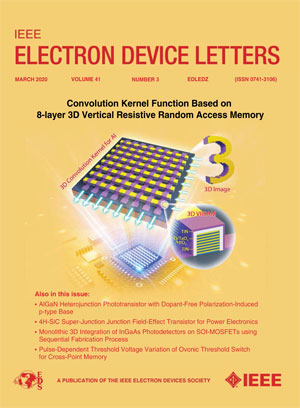Low-Temperature and Solution-Processed Preparation of NiOx/InGaZnO Heterostructure for UV Photodetector
IF 4.1
2区 工程技术
Q2 ENGINEERING, ELECTRICAL & ELECTRONIC
引用次数: 0
Abstract
Remarkable progress has been achieved in InGaZnO (IGZO) films for thin film transistors. Preserving comparable performance in optoelectronic applications as in electronic applications is challenging. The study introduces a low-temperature and solution-processed method to construct an IGZO-based heterostructure photodetector. A nickel oxide (NiO低温固溶法制备UV光电探测器用NiOx/InGaZnO异质结构材料
用于薄膜晶体管的InGaZnO (IGZO)薄膜已经取得了显著的进展。在光电应用中保持与电子应用相当的性能是具有挑战性的。本研究介绍了一种低温溶液处理的方法来构建基于igzo的异质结构光电探测器。将氧化镍(NiO ${}_{x}\text{)}$薄膜作为缓冲层印在IGZO上,在$150~^{\circ}$ c温度下退火后形成致密的界面。结果表明,器件的光电流和性能得到了提高。在254 nm入射光下,得到了最高的光暗电流比(PDCR) $10^{{5}}$。器件的响应率为0.9 a /W,探测率为$10^{{11}}$ Jones。此外,探测器表现出良好的灵活性和长期稳定性。无封装,运行30天后保持初始值。这项工作为制造高性能和柔性的基于igzo的光电器件提供了一种方法。
本文章由计算机程序翻译,如有差异,请以英文原文为准。
求助全文
约1分钟内获得全文
求助全文
来源期刊

IEEE Electron Device Letters
工程技术-工程:电子与电气
CiteScore
8.20
自引率
10.20%
发文量
551
审稿时长
1.4 months
期刊介绍:
IEEE Electron Device Letters publishes original and significant contributions relating to the theory, modeling, design, performance and reliability of electron and ion integrated circuit devices and interconnects, involving insulators, metals, organic materials, micro-plasmas, semiconductors, quantum-effect structures, vacuum devices, and emerging materials with applications in bioelectronics, biomedical electronics, computation, communications, displays, microelectromechanics, imaging, micro-actuators, nanoelectronics, optoelectronics, photovoltaics, power ICs and micro-sensors.
 求助内容:
求助内容: 应助结果提醒方式:
应助结果提醒方式:


